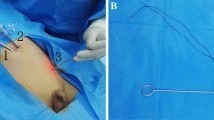Abstract
Background
Laparoscopic repair is widely performed for the management of pediatric inguinal hernia (PIH), and different laparoscopic surgical methods are used. Herein, we present the application of laparoscopic totally extraperitoneal ligation (TEPL), which is a novel surgical method for PIH repair and is similar to traditional high ligation.
Methods
In this study, 103 pediatric patients underwent laparoscopic TEPL for inguinal hernia. Data including demographic characteristics, clinical presentation, time of surgery, length of hospital stay, and postoperative complications were analyzed retrospectively.
Results
The patient’s median age at surgery was 4.3 years, and the median body weight at surgery was 18 kg. The preoperative diagnoses were as follows: n = 53, right inguinal hernia; n = 45, left inguinal hernia; and n = 5, bilateral inguinal hernia. All patients were discharged on the day of surgery. The operative times were 27.2 min for unilateral inguinal hernia and 28.8 min for bilateral inguinal hernia. All patients, except one who had scrotal bruise, did not present with postoperative complications.
Conclusions
Laparoscopic TEPL, which is similar to traditional high ligation, is used for the treatment of PIH. Moreover, it is safe, beneficial, and feasible. Double ligation is performed on the extraperitoneal space, and the assessment of contralateral patent processus vaginalis is not complex. However, further studies should be conducted to assess for long-term outcomes.








Similar content being viewed by others
References
Snyder CL, Escolino M, Esposito C (2020) Inguinal hernia. In: Holcomb GW III, Murphy JP, St Peter SD (eds) Holcomb and Ashcraft’s pediatric surgery, 7th edn. Elsevier, China, pp 784–804
Read RC (2009) Herniology: past, present, and future. Hernia 13:577–580
Smith AK, Speck KE (2018) Pediatric laparoscopic inguinal hernia repair: a review of techniques. SAGES, https://www.sages.org/wiki/pediatric-laparoscopic-inguinal-hernia-repair-a-review-of-techniques/. Accessed 23 Feb 2021
Johnson J, Roth JS, Hazey JW, Pofahl WE (2004) The history of open inguinal hernia repair. Curr Surg 61:49–52
Schier F (2006) Laparoscopic inguinal hernia repair—a prospective personal series of 542 children. J Pediatr Surg 41:1081–1084
Becmeur F, Philippe P, Lemandat-Schultz A, Moog R, Grandadam S, Lieber A, Toledano D (2004) A continuous series of 96 laparoscopic inguinal hernia repairs in children by a new technique. Surg Endosc 18:1738–1741
Spurbeck WW, Prasad R, Lobe TE (2005) Two-year experience with minimally invasive herniorrhaphy in children. Surg Endosc 19:551–553
Takehara H, Yakabe S, Kameoka K (2006) Laparoscopic percutaneous extraperitoneal closure for inguinal hernia in children: clinical outcome of 972 repairs done in 3 pediatric surgical institutions. J Pediatr Surg 41:1999–2003
Esposito C, Escolino M, Farina A, Settimi A (2014) Two decades of history of laparoscopic pediatric inguinal hernia repair. J Laparoendosc Adv Surg Tech A 24:669–670
Esposito C, Escolino M, Turra F, Roberti A, Cerulo M, Farina A, Caiazzo S, Cortese G, Servillo G, Settimi A (2016) Current concepts in the management of inguinal hernia and hydrocele in pediatric patients in laparoscopic era. Semin Pediatr Surg 25:232–240
Montupet P, Esposito C (1999) Laparoscopic treatment of congenital inguinal hernia in children. J Pediatr Surg 34:420–423
Schier F (2000) Laparoscopic surgery of inguinal hernias in children—initial experience. J Pediatr Surg 35:1331–1335
Parelkar SV, Oak S, Gupta R, Sanghvi B, Shimoga PH, Kaltari D, Prakash A, Shekhar R, Gupta A, Bachani M (2010) Laparoscopic inguinal hernia repair in the pediatric age group—experience with 437 children. J Pediatr Surg 45:789–792
McKernan JB, Laws HL (1993) Laparoscopic repair of inguinal hernias using a totally extraperitoneal prosthetic approach. Surg Endosc 7:26–28
Aiolfi A, Cavalli M, Micheletto G, Lombardo F, Bonitta G, Morlacchi A, Bruni PG, Campanelli G, Bona D (2019) Primary inguinal hernia: systematic review and Bayesian network meta-analysis comparing open, laparoscopic transabdominal preperitoneal, totally extraperitoneal, and robotic preperitoneal repair. Hernia 23:473–484
Li Y, Wu Y, Wang C, Wang Q, Zhao Y, Ji Y, Xiang B (2019) Incidence of pediatric metachronous contralateral inguinal hernia and the relationship with contralateral patent processus vaginalis. Surg Endosc 33:1087–1090
Zhong H, Wang F (2014) Contralateral metachronous hernia following negative laparoscopic evaluation for contralateral patent processus vaginalis: a meta-analysis. J Laparoendosc Adv Surg Tech A 24:111–116
Karabulut B (2011) One surgeon experiences in childhood inguinal hernias. J Korean Surg Soc 81:50–53
Bittner R, Arregui ME, Bisgaard T, Dudai M, Ferzli GS, Fitzgibbons RJ, Fortelny RH, Klinge U, Kockerling F, Kuhry E, Kukleta J, Lomanto D, Misra MC, Montgomery A, Morales-Conde S, Reinpold W, Rosenberg J, Sauerland S, Schgu-Paß C, Singh K, Timoney M, Weyhe D, Chowbey P (2011) Guidelines for laparoscopic (TAPP) and endoscopic (TEP) treatment of inguinal hernia [International Endohernia Society(IEHS)]. Surg Endosc 25:2773–2843
Stylianidis G, Haapamaki MM, Sund M, Nilsson E, Nordin P (2010) Management of the hernial sac in inguinal hernia repair. Br J Surg 97:415–419
Acknowledgements
Thanks to RN Jaesoon Park and Jihee Yun for organizing data.
Author information
Authors and Affiliations
Corresponding author
Ethics declarations
Disclosures
Eun-jung Koo and Eunyoung Jung have no conflicts of interest or financial ties to disclose.
Additional information
Publisher's Note
Springer Nature remains neutral with regard to jurisdictional claims in published maps and institutional affiliations.
Rights and permissions
About this article
Cite this article
Koo, Ej., Jung, E. Laparoscopic totally extraperitoneal ligation for pediatric inguinal hernia: a novel surgical treatment. Surg Endosc 36, 1320–1325 (2022). https://doi.org/10.1007/s00464-021-08408-y
Received:
Accepted:
Published:
Issue Date:
DOI: https://doi.org/10.1007/s00464-021-08408-y




